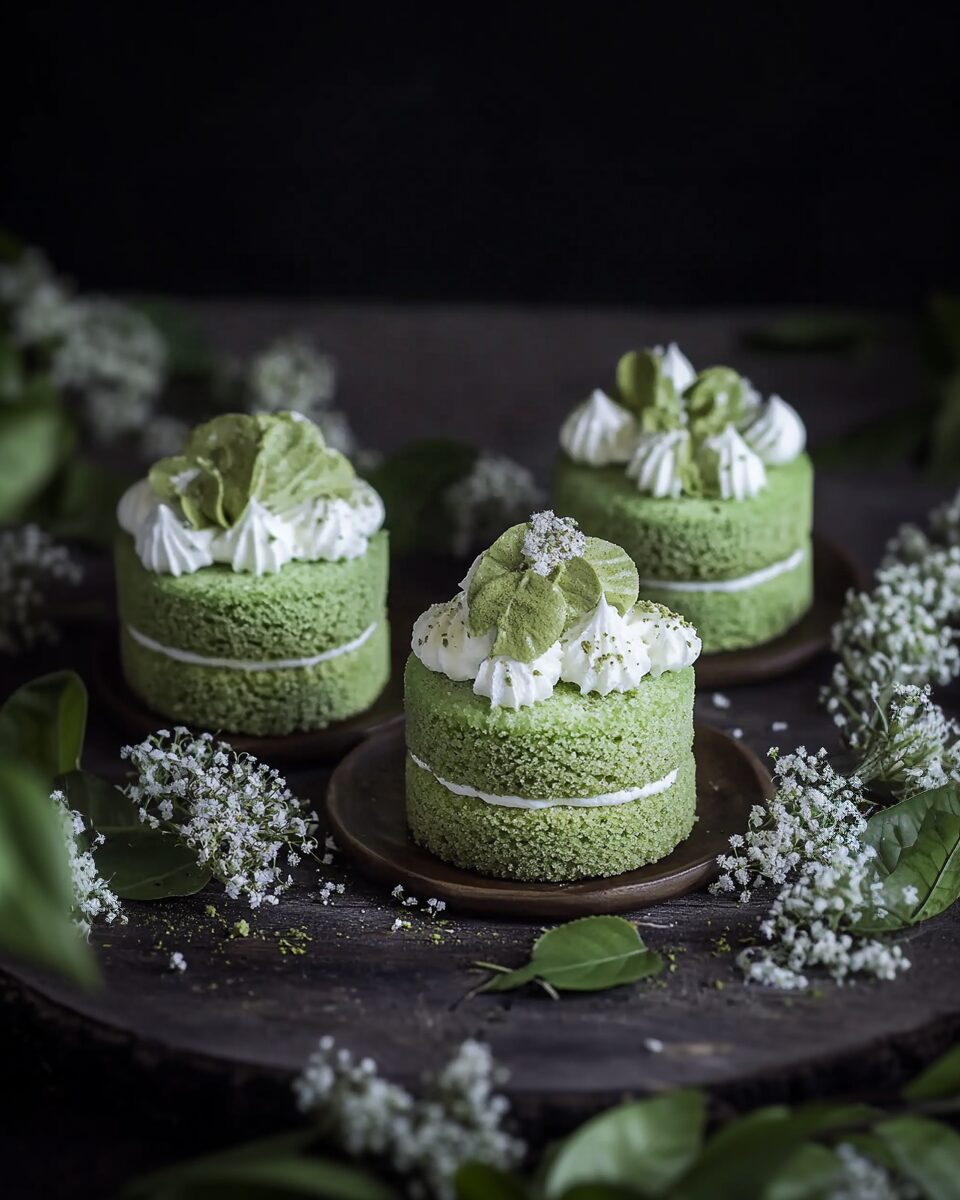These Matcha Green Tea Mini Cakes are a delightful fusion of Japanese flavors and European elegance. Infused with earthy matcha and layered with a rich mascarpone frosting, these individual-sized cakes are perfect for sophisticated gatherings or a personal indulgence. Their vibrant green hue and delicate taste bring a touch of refinement to any dessert table.
Full Recipe:
Ingredients
For the Cakes:
- 40 g softened butter
- 100 g sugar
- 100 g flour
- 40 ml milk
- 4 eggs
- ½ tsp baking powder
- 10 g matcha powder
- Vanilla extract
- Pinch of salt
For the Mascarpone Frosting:
- 50–100 g powdered sugar
- 125 g cold mascarpone
- 250 ml fresh cream
- Vanilla extract
Directions
- In a heatproof bowl, combine eggs, sugar, and vanilla extract. Warm over a bain-marie until the mixture reaches 40°C.
- Remove from heat and beat with an electric mixer for 5–10 minutes until the mixture is white, fluffy, and has doubled in volume.
- Sift together flour, baking powder, and matcha powder. Gently fold into the egg mixture using a spatula, taking care not to deflate the batter.
- Melt the butter with the milk and let it cool. Fold into the batter gently.
- Pour the batter into an 18 cm diameter baking pan lined with parchment paper.
- Bake in a preheated oven at 175°C for 35–40 minutes. Allow to cool completely.
- For the frosting, combine all ingredients in a bowl and beat with an electric mixer until fluffy.
- Once the cake has cooled, use an 8 cm diameter pastry cutter to cut out 6 discs.
- Spread mascarpone cream on one disc, top with another disc, and repeat the process to assemble the mini cakes.
- Dust the tops with matcha powder for decoration.
Nutritional Facts
Note: Nutritional values are approximate per serving (1 mini cake):
- Calories: Approximately 300–350 kcal
- Total Fat: 20–25 g
- Saturated Fat: 12–15 g
- Cholesterol: 100–120 mg
- Sodium: 50–70 mg
- Total Carbohydrates: 25–30 g
- Sugars: 15–20 g
- Protein: 5–7 g
The Cultural Significance of Matcha
Matcha holds a special place in Japanese culture, where it has been consumed for centuries as part of the traditional tea ceremony. Unlike other green teas, matcha involves grinding whole tea leaves into a fine powder, which is then whisked with hot water to produce a vibrant green drink. This method means you consume the entire leaf, resulting in a more potent source of antioxidants and nutrients.
In the culinary world, matcha has transcended its original use as a beverage and become a key ingredient in sweets and baked goods. It symbolizes a fusion of health and indulgence, offering a unique flavor that complements everything from cakes and cookies to ice cream and chocolates.
Why Choose Mini Cakes?
Mini cakes are increasingly popular because they offer the perfect portion size for individual enjoyment without the guilt of overeating. They also provide an opportunity for creative presentation and are ideal for gatherings, where guests can sample different flavors without committing to a large slice.
Matcha Green Tea Mini Cakes stand out not only because of their flavor but also their aesthetics. Their vibrant green color adds a striking visual appeal, making them perfect for festive occasions, bridal showers, or afternoon teas. The individual size also allows for easy customization, whether through additional toppings, layers, or complementary flavors like citrus zest or white chocolate.
Health Benefits of Matcha in Baking
Incorporating matcha into desserts isn’t just about flavor—it’s also a nod to wellness. Matcha is loaded with antioxidants, particularly catechins, which are known to fight free radicals and support overall health. It also contains L-theanine, an amino acid that promotes relaxation without drowsiness, making matcha desserts a gentle pick-me-up.
When used in cakes, matcha offers a slight caffeine boost, but much milder and steadier compared to coffee, which can be appealing for those seeking a balanced energy lift. Furthermore, matcha’s anti-inflammatory and metabolism-boosting properties make it a better choice for dessert flavoring compared to more processed or sugary alternatives.
The Art of Balancing Flavors
One of the keys to a successful Matcha Green Tea Mini Cake lies in balancing the bold, sometimes bitter notes of matcha with the sweetness and creaminess of other ingredients. The buttery cake base helps mellow the matcha’s earthiness, while the mascarpone frosting adds a rich, velvety texture that complements the cake without overwhelming it.
Perfecting this balance is an art form, requiring careful adjustment of sugar levels and the quality of the matcha powder used. Higher quality ceremonial grade matcha provides a smoother, more delicate flavor, while culinary grade tends to be more robust and slightly bitter. Knowing your audience and their preferences is essential to crafting the perfect matcha dessert.
Mascarpone Frosting: A Creamy Contrast
The choice of mascarpone for the frosting is inspired. This Italian cream cheese is less tangy than traditional cream cheese, with a smooth, rich texture that pairs exceptionally well with the subtle bitterness of matcha. Its mild flavor enhances the overall creaminess of the cake without competing with the tea flavor.
The frosting’s lightness also prevents the cake from feeling too heavy, making each bite a perfect blend of airy and dense textures. Adding vanilla extract and powdered sugar creates a subtle sweetness that rounds out the frosting and complements the matcha’s complex flavor.
Presentation and Serving Suggestions
Matcha Green Tea Mini Cakes are visually stunning. Their bright green layers and dusting of matcha powder make for an elegant presentation. These mini cakes can be served as is or decorated with additional elements such as edible flowers, white chocolate curls, or a drizzle of honey.
They pair wonderfully with light beverages like jasmine tea, green tea, or even a crisp glass of sparkling wine. Serving these cakes at afternoon teas, bridal showers, or holiday parties will impress guests and provide a unique alternative to more traditional desserts.
Versatility and Variations
While the classic Matcha Green Tea Mini Cake recipe is wonderful on its own, the dessert is versatile enough to allow for many creative variations. You can experiment with adding citrus zest—like lemon or yuzu—to the cake batter for a bright contrast to the matcha’s earthiness. Alternatively, incorporating layers of red bean paste or black sesame cream can introduce a more pronounced Asian flavor profile.
For those who prefer a dairy-free option, coconut cream frosting can replace mascarpone, offering a tropical twist that pairs nicely with matcha. You can also explore different cake bases, such as sponge cake or chiffon, to adjust the texture according to preference.
Pairing Matcha Cakes with Other Desserts
In a dessert spread, Matcha Green Tea Mini Cakes can serve as a sophisticated centerpiece alongside complementary sweets. They pair well with light, fruity desserts like citrus sorbets or berry compotes, which enhance their subtle flavors without overpowering them.
Serving alongside traditional Japanese sweets, such as mochi or dorayaki, can create a themed dessert experience. Alternatively, pairing with a mild white chocolate mousse or panna cotta offers a creamy counterpart that complements the matcha perfectly.
Storage and Shelf Life
Due to the mascarpone frosting and the delicate nature of the cake, these mini cakes are best enjoyed fresh but can be stored in the refrigerator for up to 2–3 days. It is recommended to keep them covered tightly to prevent the cake from drying out or absorbing other fridge odors.
If you want to prepare in advance, you can bake the cakes ahead and freeze the unfrosted layers. When ready to serve, thaw them slowly in the refrigerator and frost just before serving to maintain freshness and texture.
Environmental and Ethical Considerations
Using high-quality, sustainably sourced matcha powder supports environmentally friendly farming practices. When purchasing matcha for baking, it’s worth investing in brands that prioritize organic and shade-grown cultivation, which helps maintain soil health and reduces pesticide use.
Additionally, choosing mascarpone from local dairies or ethical producers supports sustainable farming and ensures a fresher, more flavorful product. These considerations contribute to a better overall dessert experience, aligning with conscious consumption trends.
Conclusion
Matcha Green Tea Mini Cakes are more than just a dessert—they are a celebration of culture, flavor, and artistry. Combining the rich traditions of Japanese matcha with the creamy indulgence of mascarpone frosting, these mini cakes offer a unique and elegant treat suitable for any occasion. Their vibrant color, balanced flavors, and refined presentation make them a standout on any dessert table.






